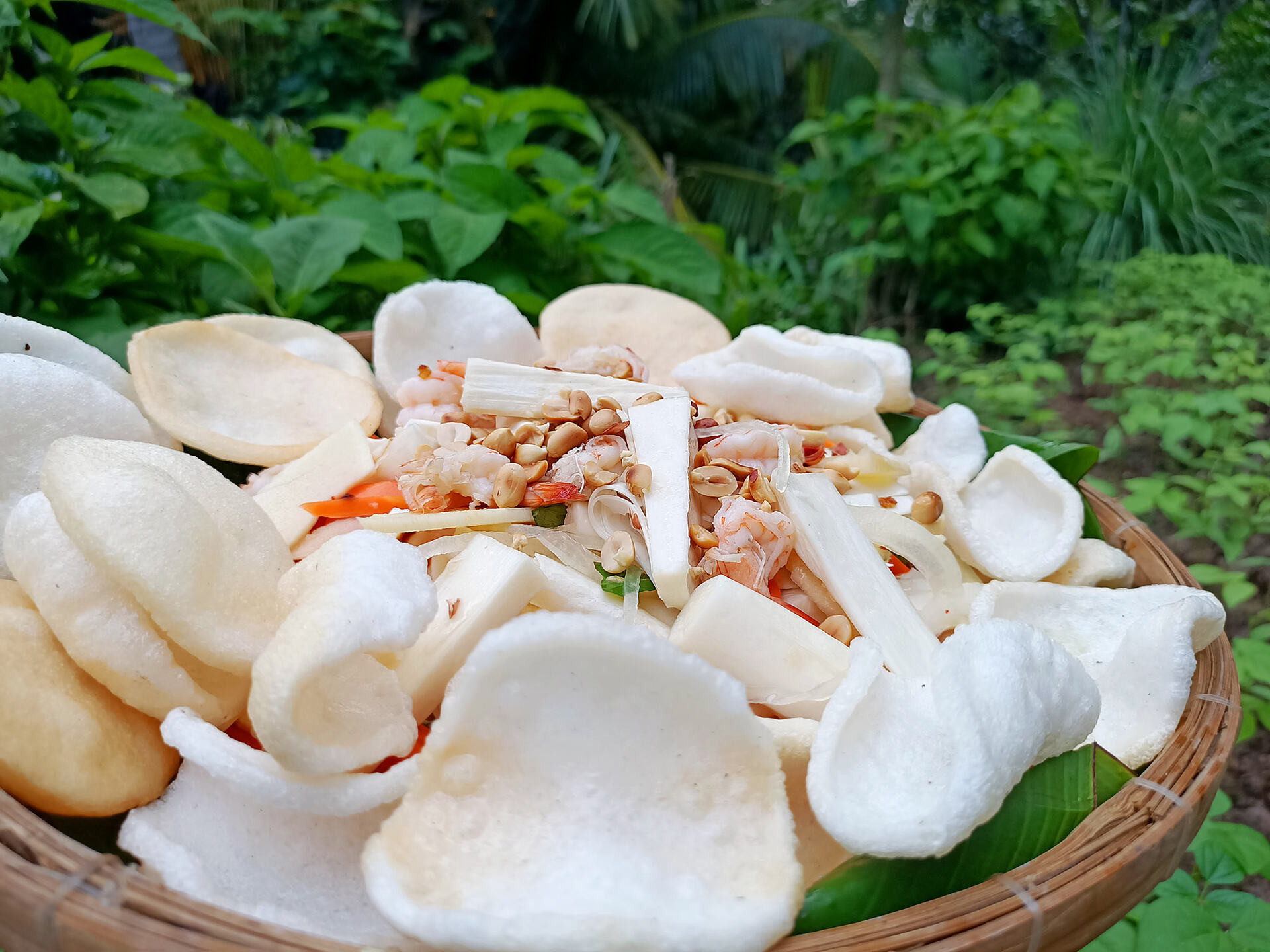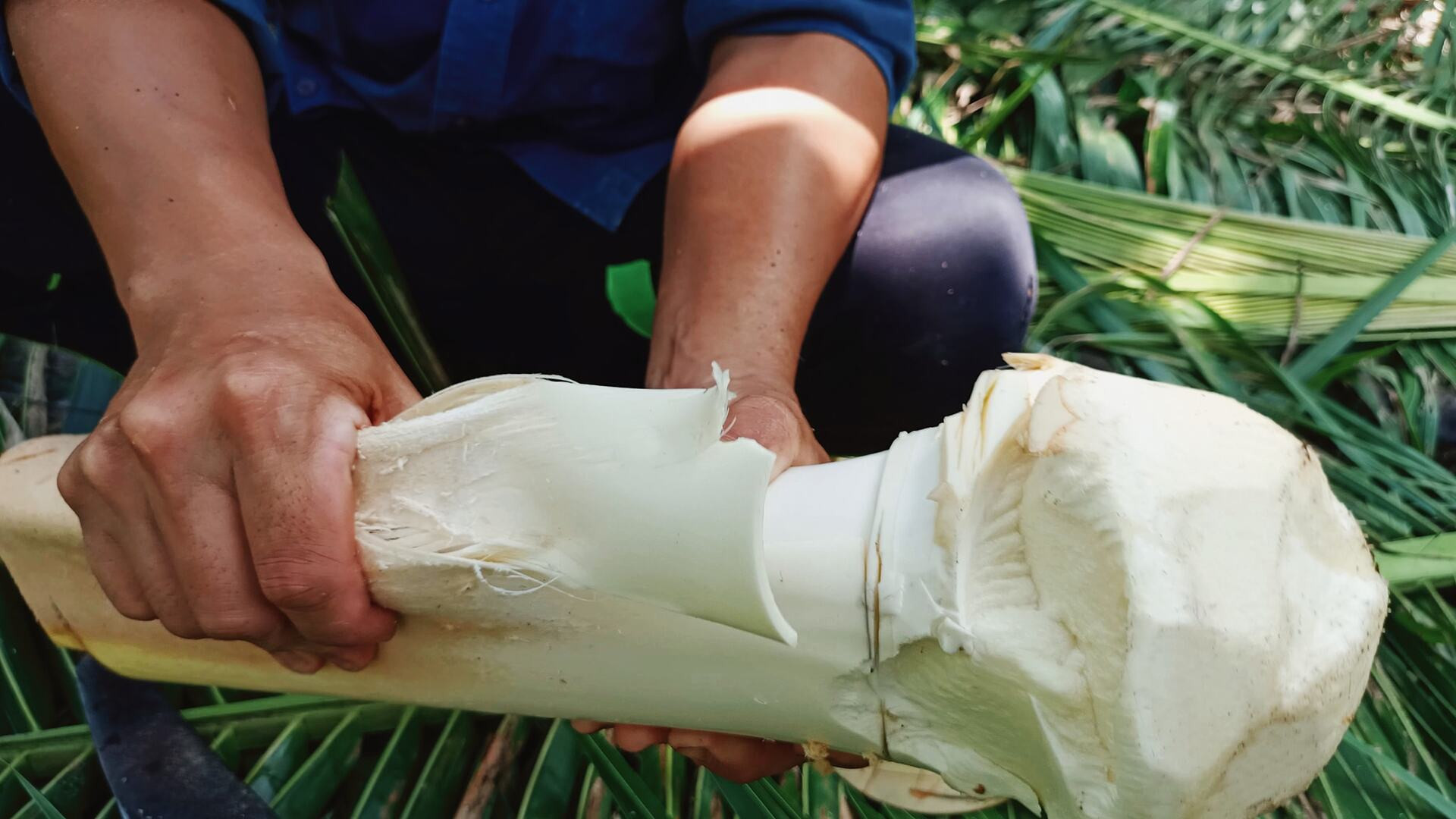
Coconut heart, or ‘cu hu dua’ as called by locals, is the tender core at the top of the coconut tree’s trunk, nestled deep within, consisting of unemerged buds and leaf stalks.
Freshly harvested coconut heart is snowy white, tender, crisp, and refreshingly sweet. In the Mekong Delta, it is used to make rustic dishes like sour soup, braised with fermented soybean paste, or stir-fried with small shrimp.
Raw coconut heart is delicious when freshly cut, but eating too much can cause dizziness or nausea.
Dubbed a “luxurious” delicacy in Ben Tre and many Mekong Delta provinces, coconut heart was once a rare treat. To harvest just a few kilograms of this pristine white treasure, locals had to cut down an entire coconut tree several years old.
In general, harvesters seek coconut hearts in trees two years old or more, those that are “aging,” or no longer productive in fruit yield, or damaged by storms.
Harvesters climb to the top and trim the leaves and fruit before felling the tree. The remaining parts of the coconut tree are sold for different purposes, from roofing to crafting. Almost nothing goes to waste.
Nowadays, many Mekong Delta farmers have started cultivating coconut trees specifically to harvest coconut hearts. The cultivation just lasts two years, with stable demand and good income.
Coconut heart is favored not only for its clean, delicious taste but also for its high fiber content, digestive benefits, and rich nutritional profile, including trace elements and minerals like iron, magnesium, and zinc.
At collecting and processing facilities, coconut heart is peeled, lightly rinsed, and vacuum-sealed immediately to prevent getting brown and preserve its snowy white color, enabling transport to distant markets.

Coconut heart is sold in major cities for VND80,000–120,000 per kilogram. In Hanoi, prices can reach VND150,000 per kilogram.
Local farmers revealed that to keep coconut heart white and crisp, they cut it into chunks or thin slices after harvesting, soak it in ice water, and add a touch of fresh lemon and salt.
“In the past, coconut heart was only harvested when a felled tree was damaged by pests eating the shoots. It was delicious and versatile, but it wasn’t always available to enjoy,” said Nguyen Nguyen Gia Bao, 27, from Ben Tre, now living in Dong Nai.
Banh xeo cu hu dua, or crispy Vietnamese pancake with coconut heart, is a traditional dish in Ben Tre, often served during the Tet Doan Ngo, or mid-year festival (5th day of the 5th lunar month).
“When people think of Mekong Delta banh xeo, they imagine fillings like shrimp, pork, and bean sprouts. But in my hometown Ben Tre, we often use minced duck, shrimp, and coconut heart as the filling,” Bao explained.
The banh xeo batter is mixed with rich coconut milk and turmeric, resulting in a thin, golden, crispy shell when fried. Coconut heart is peeled into small layers, finely sliced, and lightly stir-fried with minced boneless duck, fresh shrimp, and seasoning.
Shrimp is added to a hot, greased pan, followed by a ladle of batter that sizzles on contact. The shrimp adheres to the shell as it cooks. Once the batter is just set, the coconut heart filling is added.
“The special characteristic and the soul of Mekong Delta banh xeo lies in the variety and freshness of the accompanying greens,” Bao said.
It’s not just a main dish for Mekong Delta, but a harmony of flavors with greens like mustard greens, fish mint, tamarind leaves, cashew leaves, mango leaves, and purple amaranth shoots. The oversized banh xeo, paired with spicy-sour fish sauce, is a complete experience,” Bao said.
Coconut heart salad is also a renowned Mekong Delta dish, featured in restaurants to serve visitors from afar. This dish offers a sweet-sour, crisp, refreshing, and low-fat taste.
Coconut heart is thinly sliced, mixed with peeled shrimp, pork belly, thinly sliced pig’s ear, Vietnamese coriander, onion, and sweet-sour fish sauce. A sprinkle of roasted peanuts and crispy shrimp crackers enhances its appeal.
Coconut heart and shrimp can also be mixed to make a stir-fried dish. Fresh shrimp is cleaned and sautéed with garlic, followed by carrots, coconut heart and broth. Seasoned with oyster sauce, spices, sugar, and herbs, the dish is finished with a dash of pepper and spicy fish sauce, making it a perfect rice companion.
Linh Trang